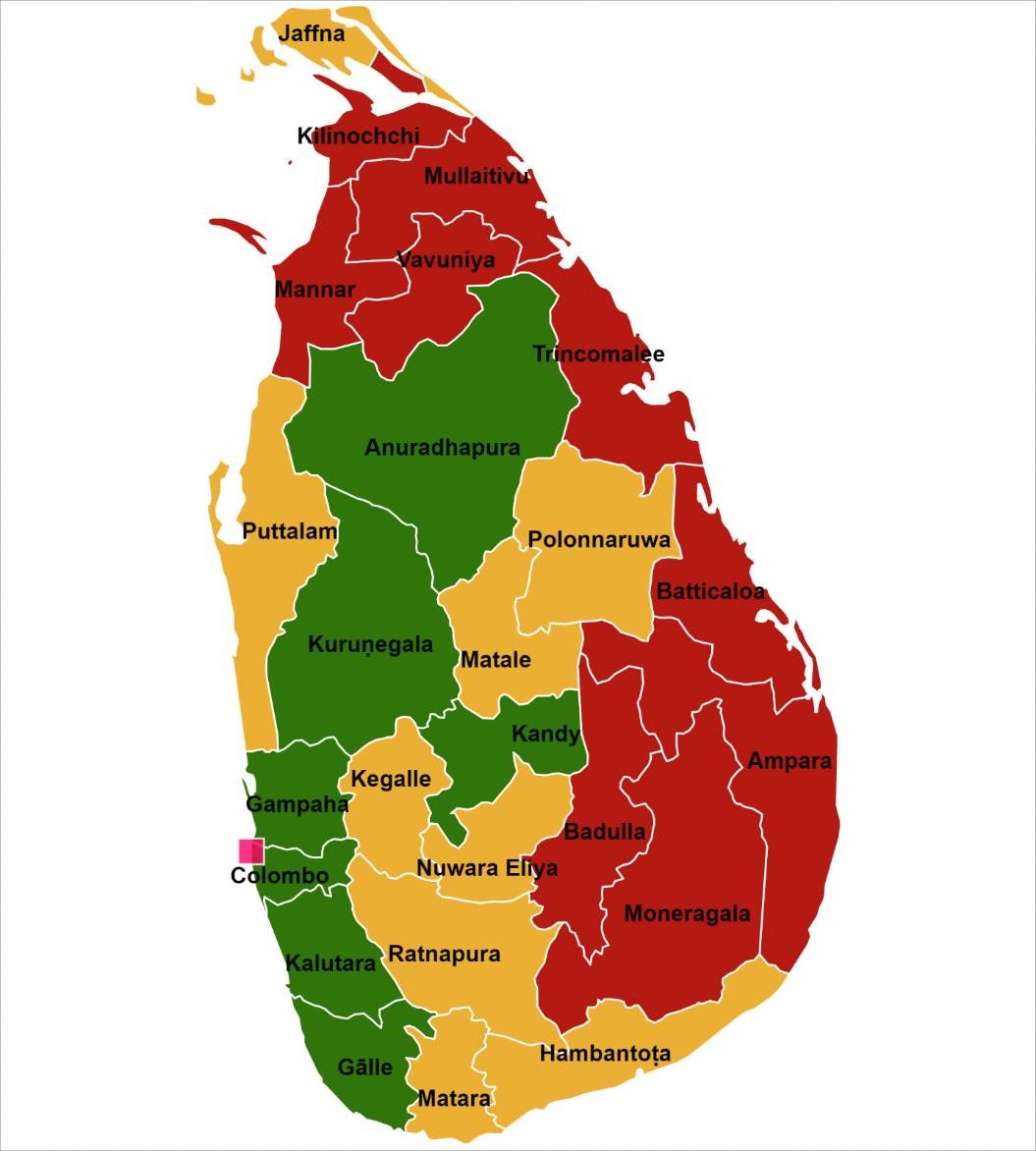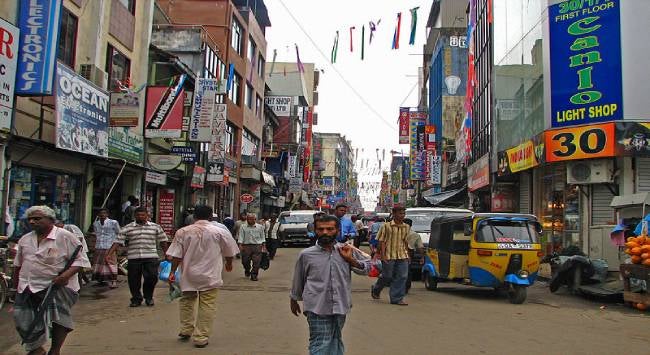Disparities of Subnational Economies of Sri Lanka:
A District-Level Analysis
Tilak Abeysinghe, Nethmini Gunarathna
7 July 2023Summary
A regular assessment of regional disparities is essential for an evolving policy framework aimed at balanced regional development. In Sri Lanka, because of data constraints, subnational assessments are often carried out at the provincial level. Such aggregate analyses may overlook intra-provincial disparities. The district-level analysis carried out in this exercise shows the persistence of some disparities though there has been some convergence in certain aspects like improvement in quality of life.
Introduction
A balanced regional development of Sri Lanka has been a priority policy consideration over many decades, even before independence in 1948. The Finance Commission was established in 1987 to provide recommendations to the government for fund allocation for balanced development across provinces. Intentions, however, have not translated into actions in effective ways to reduce regional disparities. As history bears evidence, excessive disparities lead to discontent and disruptive conflicts and turmoil. A regular assessment of regional disparities is essential for an evolving policy framework. As a result of data constraints, disparities at the subnational level in Sri Lanka are often assessed at the provincial level which tends to overlook intra-provincial disparities. Broad-brush policy measures that may direct investment to hub districts of the provinces may further aggravate intra-provincial disparities. This exercise lays the foundation for a district-level analysis.
Methodology
The basic analytical framework of the exercise is similar to that of the Asia Competitiveness Institute in the National University of Singapore. In this framework, the analysis is carried out under four environments – Macroeconomic Stability; Government and Institutional Setting; Financial Business and Manpower Conditions; and Quality of Life and Infrastructure Development. What is novel in our study is the District Development Index (DDI) which helps in assessing the convergence or divergence of districts relative to a base year.
After studying more than 100 indicators, the study narrowed them down to 53 indicators based on the quality-quantity trade-off. The indicators are standardised and aggregated into successive levels of sub-environments, environments and overall. District scores and ranks (both standard and DDI) constitute the basic units of the analysis.
Driven by data constraints, the initial analysis covers the years 2012, 2016 and 2019, with some extensions to 2020 and 2021. The DDI-2016 uses 2012 as the base year and DDI-2019 uses 2016 as the base year. The rank correlation between the district ranks of the base year (standard ranks) and the reference year (DDI ranks) conveys information on convergence or divergence. A negative rank correlation (subject to another condition) indicates that the worst-performing districts in the base year have improved the most in the reference year.
Results
- Gross Regional Domestic Product (GRDP) over 2010-2019 at the district level shows the existence and persistence of substantial intra-provincial disparities, especially in the Northern, North-Central and North-Western Provinces.
- The overall standard ranking shows the unsurprising result that the districts of the Western Province stayed at the top (with Colombo leading) in 2012, 2016 and 2019. The top seven also include Kurunegala, Kandy, Galle and Anuradhapura. The bottom nine include the districts of the Northern Province (excluding Jaffna), Uva Province and the Eastern Province. The remaining nine districts are in the middle.
- The DDI scores indicate progressive convergence over both periods – 2012-16 and 2016-19 – with weaker improvement over the latter. These results are, however, subject to the ‘fallacy of aggregates’.
- Disaggregating to the level of four environments shows progressive divergence in Macroeconomic Stability; and Government and Institutional Setting over 2012-16 and regressive convergence in Government and Institutional Setting over 2016-19. The latter is a result of a substantial drop in the allocation of capital expenditure to provincial councils in 2019. The combined effect is to produce the overall result mentioned in Point 3 above.
- Progressive convergence is observed in the Quality of Life and Infrastructure Development under both periods, with 2012-16 showing stronger results.
- Disaggregating further to the sub-environment level (education, healthcare, income distribution, infrastructure, labour market and labour productivity) shows stronger performance over the period 2012-16.
- Agriculture labour productivity conundrum: Unlike the industry and service sectors, labour productivity of the agriculture sector has been very low and stagnant over the observed years (2010-19) across all districts except Colombo and Gampaha. This appears to be related to the pricing of agricultural products that requires a deeper analysis.
Pandemic 2020-2021 and Economic Crisis 2022
Data for the full analysis under the four environments is not available. The district-level analysis was carried out only under Macroeconomic Stability. An aggregate account of the economic crisis is provided in brief:
- Although the Gross Domestic Product growth rebounded in 2021, the growth of per capita GRDP at the district level shows a substantial contraction in 2020, without much growth in 2021. It is very likely that this effect may have fallen disproportionately on vulnerable low-income groups.
- The DDI scores (2020 and 2021) show a regressive convergence of macroeconomic conditions, with 19 districts in 2020 performing worse than 2019 and 16 districts in 2021 performing worse than 2019.
- The economic crisis started to surface with social and political unrest since March 2022. The sparks of the crisis stayed hidden for a long time. Persistent twin deficits since 1956 amply demonstrates one living beyond one’s means. The crisis is an opportune time to introduce bitter pills to cure the patient.
Map 1: Overall Standing of Districts of Sri Lanka (Top 7 – Green, Middle 9 – Amber and Bottom 9 – Red)

Source: Authors Compilation
. . . . .
Dr Tilak Abeysinghe is an Adjunct Senior Research Fellow at the Institute of South Asian Studies (ISAS), an autonomous research institute at the National University of Singapore (NUS) and a Senior Advisor of the Gamani Corea Foundation, Colombo. He was also a Professor of Economics at NUS. He can be contacted at tilakabey@nus.edu.sg. Ms Nethmini Gunarathna is a Research Assistant at the Gamani Corea Foundation. She can be contacted at nethminigunarathna94@gmail.com.The authors bear full responsibility for the facts cited and opinions expressed in this paper.
Pic Credit: Wikipedia Commons
-
 More From :
More From :
-
 Tags :
Tags :
-
 Download PDF
Download PDF



